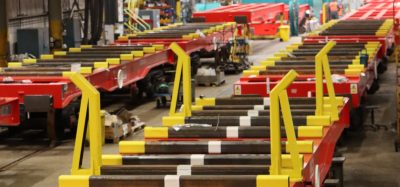FERRMED – promoting rail freight and intermodality in Europe
Posted: 5 August 2014 | | No comments yet
FERRMED is a non-profit multi-sectorial association that was founded by the private sector in Brussels in August 2004 in order to improve rail freight transportation and industrial competitiveness in Europe. Joan Amorós i Pla, Executive Secretary General of FERRMED explains more about how the association works and what it stands for…


Joan Amorós i Pla, Executive Secretary General of FERRMED
FERRMED promotes the implementation of common technical railway standards – the so-called ‘FERRMED Standards’ which are the improvement of the connections of ports and airports with their respective hinterlands; achieving the ‘Full FERRMED Corridors’ (for freight, considering only the most important parts of the EU Railway Core Network); and the conception of a Great Rail Freight Axis Scandinavia–Rhine–Rhone–Western Mediterranean.
Another key FERRMED objective is the optimisation of the full logistics chain considering appropriate inter-modality, reducing costs, increasing quality, assuring traceability and reliability, accomplishing lead times and timetables and improving management procedures in the transportation system.
FERRMED Standards
The Global Study entrusted to a prestigious European consortium of consultancy companies demonstrates that the application of FERRMED Standards is the only way to reverse the decreasing share of railway in EU land transportation and to increase its competitiveness.
For all these reasons, we strongly recommend the gradual implementation of FERRMED Standards in the EU Railway Core Network, with lead times clearly determined, considering the following key items:
- Unified coordination at EU level of the economic funds allocation for Railway Core Network development and common standards implementation.
- Reticular and polycentric Core Network with great socio-economic and intermodal impact, with two parallel rail lines (double-track each) in each corridor. One for high-speed trains (basically for passengers) and another for conventional trains (for freight and passengers at same priority rate).
- Electrified lines (preferably 25,000 volts).
- Width of the track UIC (1,435mm).
- Loading Gauge UIC – C.
- Axle load: 22.5÷25 tonnes.
- Possibility to have freight length trains reaching 1,500m and 3,600 to 5,000 tonnes. Usable length of sidings and terminals for 1,500m-long trains.
- Maximum slope: 12‰ (exceptionally 15‰ in short distances of no more than some hundred meters).
- Huge cities by-passes for freight.
- Availability of a network of intermodal polyvalent and flexible terminals with high level of performance.
- ERTMS System (at least level 2) with both ways control in each track.
- Traffic schedules available for freight transportation 24/7.
- Free competition, giving all companies access to tracks in a non-discriminatory way.
- Harmonisation and simplification of the homologation processes, administrative formalities and social legislation.
- Unified management, monitoring and tracking (through ITS) systems by Mega-Regions and main corridors coordinated at EU level, including pre-arranged train paths and reserved capacity.
- Competitive management criteria based on R+D+4i Principles (Research, Development, innovation, identity, impact and infrastructure) in the global chain of added value, including freight flows balancing.
- Favourable and homogeneous fees for the use of infrastructures.
- Reduction of the environmental impact of the freight transportation system (particularly noise, vibration and CO2 emissions) as a result of the gradual retrofitting/replacement of the old railway rolling stock, infrastructural solutions when needed and an increase of the long distance rail share on land traffic of up to 35%.
- Freight locomotive and wagon concepts adapted to FERRMED Technical Standards.
FERRMED considers that the approved Railway Core Network is so dense, that we need to select the most socio-economic important corridors of the aforementioned network, and to gradually install full FERRMED Standards on them.
Regardless of the EU Guidelines for TEN-T development (approved on 11 December 2013) only asking for Member States to compromise 750m-long trains, FERRMED insist in looking for longer trains. Therefore, FERRMED welcomes the 850m-long trains of the rolling motorway Le Boulou–Bettembourg where there was a test made recently by SNCF under Project Marathon, of a freight train 1,524m-long, between Sibelin and Nîmes, weighing 4,020 tonnes with 72 wagons and handled by two Vossloh diesel locomotives.
Inefficiency of the European transport system
Logistics costs in Europe are, on average, close to 22% of the cost of manufactured products, according to the European Logistics Association. Fifty percent of these costs are external transportation.
The results derived from the ‘Study of World Economic Forum 2009’ shows that: 24% of freight vehicles in the EU run empty; the loading of the rest is, on average, of 57% in terms of weight; the overall efficiency is only 43%; and there is an estimated recoverable loss for the EU of €160 billion/year.
Reducing these costs and balancing the inherent flows is a key issue for FERRMED.
The EU Commission White Paper on transport is aiming to reduce by 2050 greenhouse gases in the transport sector by 60%. To achieve this, by 2030, 30% of land transport has to be made by rail or barge and by 2050 this figure has to reach 50%.
Regardless of these goals, emissions of greenhouse gases from transportation in Europe are increasing in both absolute and relative terms. Without additional and strategic coordinated measures, the EU will fall far short of its own climate protection objectives.
General principles for improvement
Development of the Trans-European Transport Network
The general principles of the Trans-European Transport Network development are duly stated in the ‘Regulation (EU) No 1315/2013 of the European Parliament and of the Council of 11 December 2013 on ‘Union guidelines for the development of the Trans-European Transport Network and repealing Decision No 661/2010/EU Text with EEA relevance’.
Many of the actions included in that Regulation are related to FERRMED Standards. In that occasion we will emphasise the items concerning FERRMED Standards ‘J’, ‘N’, ‘O’ and ‘P’.
Governance of the railway system, market opening and technical approval procedures
All these matters are clearly stated in the European Commission proposals for a Fourth Railway Package (adopted on 30 January 2013). The package proposes modifications concerning a number of legislative acts like the Recast directive (on open access competition), PSO (Public Services Obligations), the Interoperability directive, the Safety directive and the ERA regulation, among others.
The FERRMED proposal for improvement
Generally speaking, FERRMED agrees with the following two points:
- The items included in the Regulation (EU) No 1315/2013. Only some discrepancies have to be stated, like the length of the trains and the loading gauge
- The content of Fourth Railway Package proposition, considering as a key matter faithfully free competition and providing non-discriminatory access to tracks to all rail operators.
The main problem arises in the accomplishment of the targets and in the coordination for the implementation of all the measures asserted in the aforementioned documents.
Application of FERRMED Standards ‘J’
This is an important issue in order to ensure an efficient multi-modal transportation, with railway being the basic mode.
In the EU Railway Core Network, especially in the full FERRMED Corridors, the following three kinds of terminals are required:
- Mega terminals in the Full FERRMED Corridors crossings and ports, with high store capacity and complementary industry
- Basic terminals in the main industrial and logistics zones, with significant store capacity
- Fast moving terminals in strategic sites to make direct exchanges of containers, mobile cases, trailers, etc., between rail-road and rail-barge, with no store capacity.
According to a FERRMED Global Study made in 2009, by 2025 it will be necessary to expand the terminals (including related industrial activities) occupied space by 50%.
Application of FERRMED Standards ‘N’ and ‘O’
The key issue in order to achieve the objectives stated in these FERRMED Standards is to reinforce the role of the European Railway Agency (ERA).
The EU has 27 railway agencies and more than 10,000 rules with very costly bureaucratic processes which manufacturing companies have to take into account in order to homologate rolling stock at European level.
For wagons the extra cost is about 10% of the manufacturing cost and, for locomotives, the homologation process amounts close to 30% of the total.
FERRMED believes that ERA should be the authority for issuing European vehicle authorisation.
Under ERA’s supervision, Member States must reduce the number of the national technical rules to those that are strictly required for network compatibility. In that sense, ERA has to become the authority for the ‘Single Safety Certification’ on which is duly stated the EU area of operation.
Also, ERA has to be the leading body regarding the implementation and coordination of management, monitoring and tracking systems, at EU level.
On the other hand, ERA has to bring together the corridors’ coordinators, because really the train paths all over the EU are linked to a network comprising several corridors, more than to just one single corridor.
Pre-arranged train paths and capacity reserved for international journeys must be another ERA responsibility.
To perform these duties, it is essential to establish the appropriate plan in order that the Agency is adequately resourced, including the suitable competence and skills.
Application of FERRMED Standard ‘P’
To achieve the targets stated in this FERRMED Standard we need a strong strategic logistics plan at EU level in order to make the land transport system more efficient and sustainable, conveniently balancing both flows and share between rail, road and barge. To accomplish this goal, ‘Open Data’ (both public and private Open Data), duly selected from Big Data, regarding transportation from one place to another of all kind of goods and by all sort of means, is vital.
Smart Applications have to be developed from the corresponding Open Data. In that sense, the tracing of trains, wagons, trucks, barges, etc., has to be perfectly known, as well as the origin and the destination of all of them.
This means the homogenisation of all kind of technical standards and certification procedures across the EU, overcoming fragmentation, considering also intelligent detection and monitoring solutions in the transportation system and single window for all reporting requirements, regardless of the form of transport.
A new Strategic Logistic Plan
We have to go forward from the previous Freight Transport Logistics Action Plan started in 2007. A new plan has to be built considering an ambitious long-term vision, but with specific targets for both the short- and medium-term.
FERRMED aims to ask the EC to look at the achievements made in the last five years and identify challenges and opportunities to determine the aforementioned new Strategic Logistic Plan with programmes and targets regarding cost reduction, increasing quality, assuring traceability and reliability, accomplishing lead times and timetables, and management enhancement in the land transportation system for the coming five years.
This Plan can be complemented with the creation of an Inter-parliamentary Group on Logistics/Supply Chains for the next term, started in 2014, as it is requested by European Logistics Platform (ELA) of which FERRMED is founding member.
Biography
Joan Amorós i Pla has a PhD in Industrial Engineering. He is currently Executive Secretary General of FERRMED, BUSINESS EUMED and R+D+4i EURO-ACTION GROUP associations as well as Member of the Board of Directors at Port of Barcelona. He is Former CEO at NISSAN Distribution Service Barcelona, S.A. (Logistics Centre for South Europe); founder member of AUTOTERMINAL, S.A. and LOGÍSTICA Y TRANSPORTE FERROVIARIO, S.A.; and General Director of Programming, Production Control, Purchasing and Distribution of NISSAN Motor Ibérica. He is author of several books, courses and conferences on logistics and management; Creu de Sant Jordi; Business Reconnaissance Medal – PIMEC 2011.







